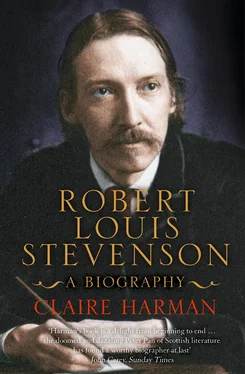Margaret was good-looking (though not a beauty), intelligent and lively. She was known as an indefatigable optimist, ‘a determined looker at the bright side of things’, as Sidney Colvin described her, ‘better skilled, perhaps, to shut her eyes to troubles or differences among those she loved than to understand, compose, or heal them’. 22 She had none of the accomplishments, such as musical or artistic ability, that were valued as bargaining counters in the marriage market (in worldly society at least), but her plainness of manner was in itself a recommendation to the God-fearing Thomas Stevenson. His surviving letters to his young bride-to-be show the tenderness and teasing tone of a man who really wanted to get married, addressing her as ‘My dearest Mag’ and indulgently calling her ‘child’. Margaret must have drawn attention to his behaviour around children (clearly a matter of some concern), for he writes to reassure her, ‘Don’t think my love that because I am strict or inclined to be strict with children that I like them less than other people. [ … ] I have the family failing of taking strong views and expressing those views strongly.’ 23 He ends the letter ‘Your ever affectionate and devoted lover’, an intensity that deepened after the marriage, when he wrote home frequently from his work trips, pining to be reunited with ‘my own dear wife’. 24 Thomas remained extremely protective and anxious about his young bride, strenuously encouraging the idea of her frailty and poor health. Their daughter-in-law Fanny’s judgement when she met them in 1880 was that Margaret – then well into middle age – was ‘adored by her husband, who spoils her like a baby’. 25
Thomas and Margaret were married about a year after they first met, on a date in August deliberately chosen to coincide with the anniversary of her father’s ordination (he, naturally, performed the ceremony). Margaret proved a most devoted wife to Thomas Stevenson, subservient to his wishes and interests, protective of his well-being, mainstay of his morale. Her chief talent, Louis declared, in one of his very few analytical remarks about his mother, was for organisation, and she was good at identifying and diverting possible starting points of domestic tension. This presumably came of years dealing with her husband’s sporadic dips into melancholia, and was a technique that her son would emulate closely in his dealings with an equally volatile spouse.
Although she became, in later life, a remarkably enthusiastic and adventurous traveller, tolerant of discomforts and extreme temperatures, game for anything, Margaret Stevenson spent her youth half in and half out of a sort of vaporous decline. She was encouraged in this first by a valetudinarian father, himself a sufferer from weak lungs, then by her hypochondriac husband. All through her son’s childhood, she varied between high spirits and sickliness: her chest was weak, her heart; she must rest, she must take the waters. She was only twenty-one when the baby was born, but stayed in bed most mornings and was unable to play or go out with him when she was up. Most of the active side of mothering was left to the child’s nurses, yet there were welcome, if perplexing, surges of energy: one of Stevenson’s earliest memories was of his mother rushing him up the stairs at their house in Inverleith Terrace to see his grandfather, as excitable and skittish as a girl.
In the summer of 1850, when Margaret was pregnant for the first and only time, old Robert Stevenson died. He had been ill for some months, but had been looking forward to his annual inspection tour of the lighthouses. When his sons tried to convince him that no more travelling was possible, the old man seemed to acquiesce, but on the day of departure ‘was found in his room, furtively packing a portmanteau’. 26 Thomas Stevenson was deeply affected by the pathos of his father’s decline and death and when his first child was born four months later, on 13 November, had no hesitation in naming the baby for him.
The little boy’s name was in fact an amalgamation of both grandfathers’, one inside the other: Robert Lewis Balfour Stevenson. The names were in strong demand in the family: Alan Stevenson had also called his first son Robert (the little boy was known as Bob), and there was a veritable epidemic of Lewis Balfours on the other side of the family; two born in 1850 (the same year as RLS), another called Lewis Henry two years earlier, Lewis (‘Noona’) in 1842, Lewis Charles in 1851. Despite that, Thomas and Margaret stuck with ‘Lewis’ for the baby’s everyday name. Or ‘Smout’, or ‘Lou’, or ‘Signor Sprucki’, or ‘Baron Broadnose’: Thomas Stevenson was a great coiner of comical aliases.
Margaret, who was weakened and possibly traumatised by the experience of childbirth, was not put through that hazard again: there were no more children. This in a family that showed typical Victorian fecundity – little Lewis had fifty-four first cousins – must have marked out the Stevenson household as a trifle eccentric. It wasn’t easy to limit a family to one child; to avoid conception successfully during a marriage that lasted another thirty-seven years must have required strict regulation of both partners’ sexual appetites. But Thomas Stevenson was not the man to put anything before his young wife’s well-being, and a challenge of this sort suited his self-mortifying temperament. However they solved the contraception issue, the couple remained conspicuously devoted and dependent, and fussed contentedly about each other’s health.
The baby made a delicate third member of this hypochondriac household. He seemed healthy enough to begin with, but an attack of croup in his third year was so alarming that ever after his parents lived in fear of another chest infection carrying him off. Both Thomas Stevenson and his wife came from large families with a high incidence of infant mortality: between them they had twelve live siblings and twelve dead ones. Consumption was a threat – Margaret had developed a patch of ‘fibroid pneumonia’ after the baby’s birth – and incipient tuberculosis seemed an increasingly plausible explanation for the child’s uneven, rickety growth and extreme thinness. 27 So whether from genuine danger, or from excessive solicitude, the child spent long stretches of time confined to bed. The catalogue of his ailments that appears in his mother’s diary is truly astonishing: in his first nine years, apart from numerous chills and colds, the boy had scarlatina, bronchitis, gastric fever, whooping cough, chickenpox and scarlet fever. But the persistent cough was what worried everyone most. It seems likely that the croup had damaged his lungs or that he suffered (among other possible things) from asthma, since his health often worsened in the damp, cold winters of smoggy Auld Reekie. The sound of his cough starting up was heard in the household with dread.
The Stevensons’ first home in Edinburgh was the one Thomas had prepared for his bride and where the baby was born, 8 Howard Place, on the northern fringes of the New Town, by the Botanic Garden. They moved in 1853 to 1 Inverleith Terrace, a larger property just around the corner. In the baby’s first years, Thomas and Margaret had a run of bad luck with nurses (or weren’t very good at choosing them): two left unbidden and the third took the infant Smoutie to a bar and left him wrapped in a shawl on the counter while she soaked up a few gins. But the fourth hire produced a family servant of the most reassuring type: sober, single and religious to a fault. Alison Cunningham was a weaver’s daughter from Fife, thirty years old when she came to the household (Margaret Stevenson was twenty-three that year) and an experienced nurse. ‘Cummy’ was given free rein with the toddler, and became a pivotal figure in the household.
Читать дальше












